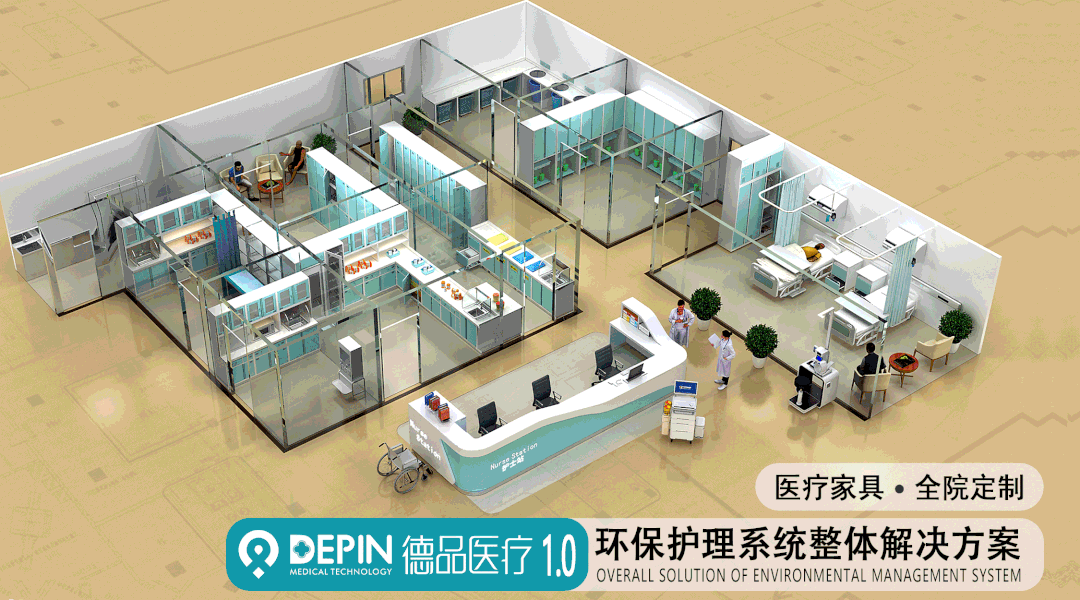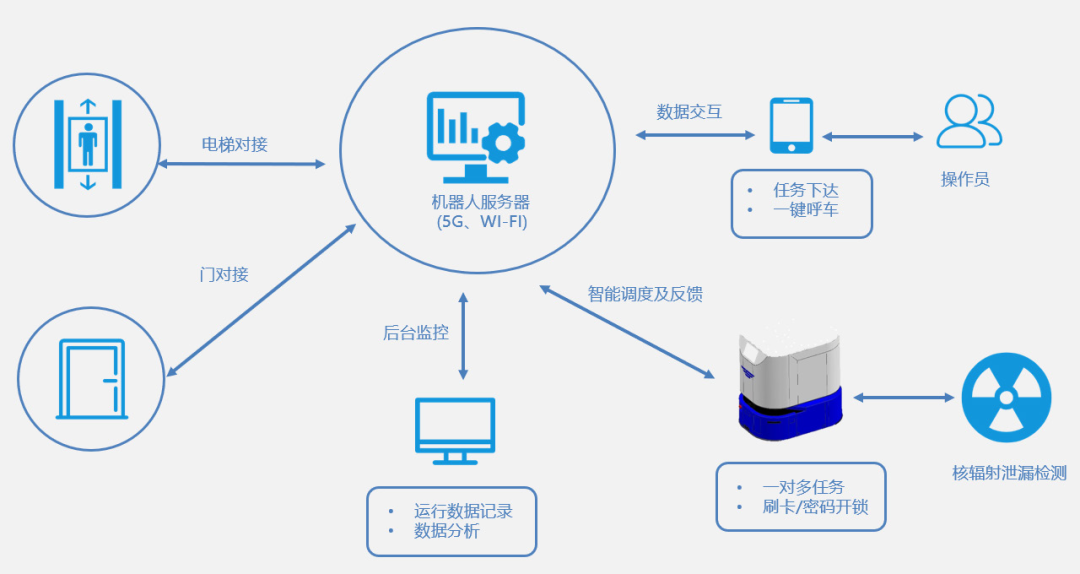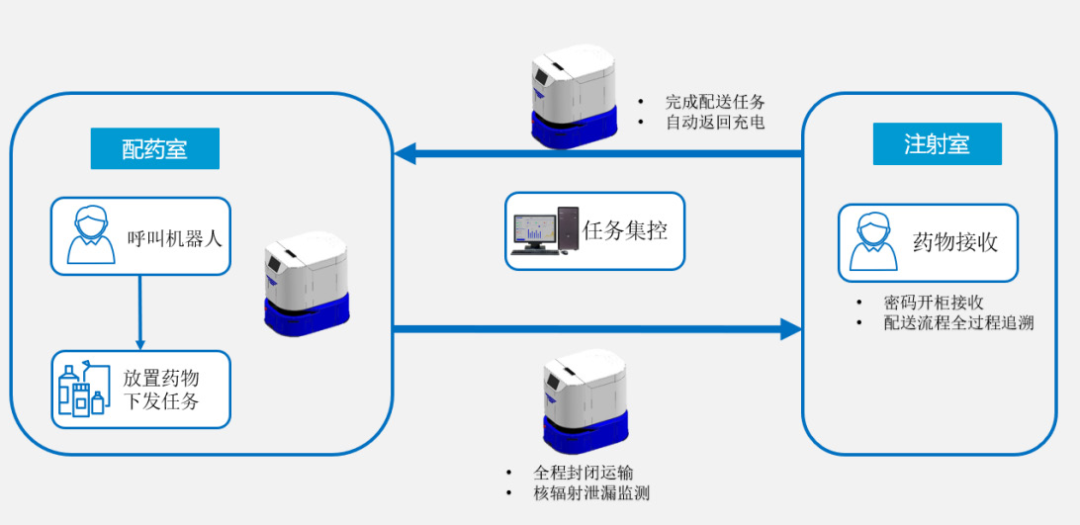Abstract
The medical logistics system is an indispensable part of modern hospital construction, with robots widely used in hospital pharmacies, laboratories, operating rooms, and wards. By understanding the workflow of nuclear medicine, analyzing the current delivery status and challenges in nuclear medicine, this article provides a solution for the delivery of nuclear medicine drugs using robots, and introduces the usage process of nuclear medicine delivery robots along with future development prospects in the field of nuclear medicine.
Written by: Yu Bin, Jiangsu Provincial People’s Hospital
In the past two centuries, the medical field has made unprecedented progress. Besides new discoveries such as the smallpox vaccine and antibiotics, the discovery of medical radiation and radioactive isotopes has provided more effective prevention, diagnosis, and treatment options for many diseases. For instance, diseases like cancer, once considered difficult to control and fatal, can now be diagnosed early using nuclear technology, allowing for more effective treatment and giving patients a glimmer of hope, with many even achieving significant chances of cure.
Nuclear medicine is a field of medicine that utilizes the accumulation and imaging effects of radioactive isotope drugs after they enter the human body for treatment or auxiliary diagnosis. The work of the nuclear medicine department mainly has two branches: nuclear medicine diagnosis and radionuclide therapy. Nuclear medicine diagnosis primarily involves imaging diagnosis, where radioactive isotopes are injected into the patient’s body. After a certain waiting period, the drugs accumulate in the area to be examined due to metabolism, and images are presented under the monitoring of scanning equipment for doctors to diagnose.
Radionuclide therapy mainly involves the use of 131I treatment: 131I (iodine-131) is primarily used to treat differentiated thyroid cancer (DTC) because thyroid cancer cells, like healthy cells, have the ability to absorb iodine. After surgical removal, high doses of radioactive iodine drugs are administered, which are absorbed by residual or metastatic thyroid cancer cells in the body, killing the cancer cells through radiation. This has become the most commonly used postoperative treatment method for thyroid cancer.
1
Delivery Process of Nuclear Medicine Drugs
The sources of nuclear medicine drugs mainly fall into two categories: externally supplied and self-prepared.
Externally supplied drugs are produced by specialized companies using industrial nuclear reactors and are delivered to the nuclear medicine department according to weekly appointment schedules. During transportation, radioactive drugs are placed in specialized protective containers. However, to prevent accidents, regulations require that radioactive drugs have independent transport entrances to minimize contact with personnel.
The second category is self-prepared drugs, where hospitals invest in building cyclotron equipment to produce short half-life PET drugs. Cyclotrons are generally built in basements, as close to the nuclear medicine department as possible, to facilitate drug transport via elevators or logistics. If conditions do not permit, manual transport using specialized containers is required, adhering to the same standards as externally supplied drugs.
Once the radionuclide drugs arrive at the nuclear medicine department, nurses need to repackage them into doses for patient use. This work is carried out in a specialized packaging cabinet with strict protective measures. Nurses insert their hands through hand holes in the cabinet to minimize contact with radioactive drugs. After repackaging, the drugs must be administered to patients as soon as possible.
Patients undergoing imaging examinations are primarily injected, while iodine treatment patients receive oral medication. The injection room is generally located adjacent to the packaging room, with an injection window installed between the two rooms. The injection window is similar to the packaging cabinet, with an observation window above; patients are on one side, and nurses on the other, with hands extending through hand holes for operation. Oral medications are passed to patients through a transfer window, where nurses guide patients and observe their reactions after taking the medication.
2
Problems with Traditional Nuclear Medicine Drug Delivery Methods
In the nuclear medicine ward, the currently widely used nuclear medicine service robots in China are equipped with voice and video capabilities and can navigate autonomously. Doctors and nurses use the robot’s video to conduct rounds, consultations, and answer questions, reducing direct contact between medical staff and patients, thereby avoiding unnecessary radiation exposure. However, in the drug delivery process, traditional lead containers are still manually transported, which presents challenges in handling and exposes personnel to radiation risks.
1
Lead Containers are Bulky and Difficult to Operate
Nuclear medicine lead containers are thick shielding containers made of lead, used for transporting or storing radioactive isotopes or other radioactive materials. Radioactive materials can emit various rays during decay reactions, which can adversely affect the human body. To reduce radiation exposure to transport personnel, lead containers are used to “shield” radiation. However, to achieve this shielding effect, lead containers typically weigh over 100 kilograms, making them difficult to transport and inevitably increasing the difficulty for personnel.
2
Radiation Hazards from Radioactive Materials to Delivery Personnel
Although using lead containers can reduce the radiation risk to transport personnel, those who frequently deliver radioactive materials inevitably have safety concerns. Through inspections of actual workflows, it has been found that younger staff, especially nursing personnel with shorter radiation work experience, may not operate according to protocols in the medication room, leading to radioactive material leaks and increasing radiation risks for transport personnel. Since delivery personnel often transport radioactive materials and their routes pass through patient waiting areas, they may come into contact with patients who have taken therapeutic doses of radioactive iodine-131, turning them into “radiation sources” and posing potential radiation hazards to surrounding individuals and medical staff. As a result, the average annual radiation exposure for delivery personnel may exceed national legal limits.
3
Delivery Process Lacks Monitoring and Traceability, Leading to Risks of Radioactive Material Loss
The traditional delivery method in hospitals is carried out by designated delivery personnel. Currently, hospitals have low entry requirements for delivery personnel, leading to varying levels of competence. During busy delivery tasks, errors in the items being delivered can easily occur. Additionally, uncertainties such as chatting with others or taking breaks during delivery can reduce efficiency, and the delivery process lacks real-time tracking of the material’s location, making it impossible to manage radioactive materials using information technology.

▲ Click to view: 【DePin Medical Co., Ltd.】 creates a smarter nursing system solution for Chinese hospitals
3
Application of Nuclear Medicine Robots
Robotics is an important branch of computer science, first applied in the 1970s, and has gradually been used in the medical field to address shortages of medical staff, alleviate insufficient medical resources, reduce diagnostic errors, and improve clinical care quality. In recent years, medical robot technology has developed rapidly, including delivery robots, surgical robots, rehabilitation and nursing robots, and diagnostic robots.
With technological advancements, fully automated dispensing and administration robots have emerged in the dispensing and administration processes, utilizing automated systems for radionuclide dispensing and collaborative robots to achieve high-precision, zero-pollution automated dispensing of medical radionuclide solutions, significantly reducing radiation exposure to medical staff.
The nuclear medicine delivery robot system completes the confirmation of the emission/reception of radioactive materials through an intelligent closed-loop management system. Managers can view the robot’s delivery status in real-time from the monitoring system, enabling full process traceability, which helps optimize the work efficiency of medical staff and reduce their radiation exposure.
1
Introduction to Nuclear Medicine Robots

Figure 1: Overview of Nuclear Medicine Robot Functions
1
Intelligent Scheduling for Multi-Destination Delivery
The robot scheduling system monitors the operational status and trajectory of all robots, dispatching them based on proximity to execute tasks, allowing for multiple destination deliveries in one trip.
2
Autonomous Elevator Use, Door Opening, and Intelligent Obstacle Avoidance
The robot communicates with elevator and door control modules via WiFi, enabling autonomous elevator use and door opening without human intervention. It can automatically avoid pedestrians or obstacles.
3
Smart Locking with Passwords
The robot uses electronic locks, allowing for unlocking via card or password, preventing unauthorized access during transport and ensuring the safe delivery of radioactive materials.
4
Nuclear Radiation Leak Monitoring
By installing nuclear radiation leak sensors inside the robot, radiation levels during transport are monitored in real-time. If leaks exceed standard values, an audible alarm is triggered, and monitoring data is uploaded to the robot system.
5
Built-in Protective Devices
In nuclear medicine applications, robots transport radioactive materials, and according to protective regulations, they must be equipped with specialized protective devices to ensure that radiation levels in the surrounding environment meet standard requirements during transport.
2
Delivery Process

Figure 2: Operation Diagram of Nuclear Medicine Robots
1
Task Issuance from the Dispensing Room
After preparing the medication, the pharmacist logs into the PAD terminal with their account password to issue a task. The robot receives the task and heads to the dispatch station. Upon arrival, the PAD terminal alerts the pharmacist to load the medication. After unlocking with a password, the pharmacist places the lead container with radioactive material into the robot, confirms the seal is intact, and finalizes the dispatch task.
2
Robot Delivers Medication
After receiving the task, the robot automatically controls doors and uses elevators along the delivery route, equipped with a password lock to ensure the safety of the transported materials, and features radiation monitoring to track radioactive material leakage in real-time. The robot’s location and status can be viewed in real-time on the system operation platform and PAD terminal interface.
3
Injection Room Receives Medication
Once the dispensing room confirms the dispatch task, the PAD terminal pushes the pending receipt task to the injection room, which can view the task status in real-time. When the robot arrives at the injection room, the PAD terminal alerts the staff to sign for the delivery. After entering the password and the recipient’s name, the medication receipt is completed.
4
Robot Completes Task and Returns
After completing the task, the robot enters a standby state. When a new task arises, the scheduling system will dispatch the robot based on proximity, ensuring safe and orderly operation to maximize efficiency.
3
Application Value
1
Saving Human Resources and Reducing Radiation Exposure for Delivery Personnel
Intelligent robots achieve unmanned delivery of radioactive materials and can operate 24/7 without interruption, directly replacing manual delivery tasks, saving labor resources, and significantly reducing repetitive actions for medical staff, allowing them to devote more time to clinical work while avoiding radiation risks.
2
Realizing Closed-Loop Management for Radioactive Materials
The robot system records the entire process from the loading of radioactive drugs, delivery, to receipt, allowing users to query information such as delivery time, recipient, and real-time delivery location, achieving closed-loop management of the drugs.
3
Real-Time Radiation Monitoring During Delivery, Reducing Nuclear Leak Risks
The robot transports radioactive materials in a fully enclosed manner, equipped with a radiation monitoring system that tracks radiation levels in real-time. If radiation levels exceed warning thresholds, the robot triggers audible and visual alarms to alert surrounding personnel, requiring manual intervention, thus forming an effective radiation monitoring and alarm system.
4
Enhancing the Safety of Radioactive Material Delivery
Compared to traditional manual delivery, which has personnel instability, robots use intelligent password locks to encrypt and protect radioactive materials, ensuring the safety of the transported substances.
5
Improving the Medical Environment and Enhancing Hospital Technology Image and Patient Satisfaction
Hospitals gather patients with various diseases, and the mixing of patients, their families, and medical staff increases the risk of radiation exposure, especially in nuclear medicine departments. Robots replacing manual delivery effectively reduce personnel movement and avoid the risk of infection, leaving more medical space for patients and improving their comfort in the environment.
4
Future Development Prospects of Nuclear Medicine Robots
With the rapid development of artificial intelligence, breakthroughs in technology, and the gradual expansion of application fields, the development of the medical industry has garnered significant attention. Medical robots, as a deepening application of artificial intelligence in the medical field, can effectively address logistics delivery in hospitals, assist doctors in a series of medical diagnoses and treatments, and promote the development of medical information technology while alleviating the tension of medical resources.
Currently, widely used nuclear medicine robots include radionuclide dispensing and dilution robots, nuclear medicine ward service robots, and nuclear medicine drug delivery robots. The challenge now is how to connect existing robots for information exchange and achieve truly intelligent unmanned delivery.
1
Connecting Radionuclide Dispensing and Dilution Robots with Nuclear Medicine Drug Delivery Robots
Radionuclide dispensing and dilution robots can replace manual operations for dispensing and diluting radioactive isotopes, improving dispensing accuracy while avoiding radiation exposure to personnel. Currently, the process from drug dispensing to robot delivery still requires manual operation, increasing radiation risks for personnel. Once the two types of robots are automatically connected, the entire process from drug dispensing and dilution to delivery can be automated, achieving true intelligence.
2
Challenges of Nuclear Medicine Delivery Robots Crossing Clean and Non-Clean Areas
Robots enter the dispensing room through transfer windows for drug delivery, and the challenge is how to facilitate and enhance the effectiveness of robot disinfection when transitioning from non-clean to clean areas. Robots typically use ultraviolet disinfection, which, according to relevant regulations, requires a disinfection time of no less than 30 minutes, inevitably affecting the delivery efficiency of the robots, which is a pain point for the future development of nuclear medicine robots.
References
Reference Documents
|
[1] |
Nicole Jawerth. Overview of Nuclear Medicine and Radioactive Therapy [J]. International Atomic Energy Agency Bulletin. 2014, 12; 5-7. |
|
[2] |
Zhou Weina, Zhang Kaixiu. Preliminary Application and Prospects of Artificial Intelligence Robots in Nuclear Medicine Wards [J]. International Journal of Radiology and Nuclear Medicine. 2020, 44(12); 750-754. |
|
[3] |
Lu Yanjun, Guo Guanghua et al. Personal Dose Monitoring and Radiation Protection for Radiotherapy Staff in a Hospital [J]. Chinese Journal of Radiation Health. 2015, 24(4); 342-343. |

END




Click “Read the original text” to find more content you need
